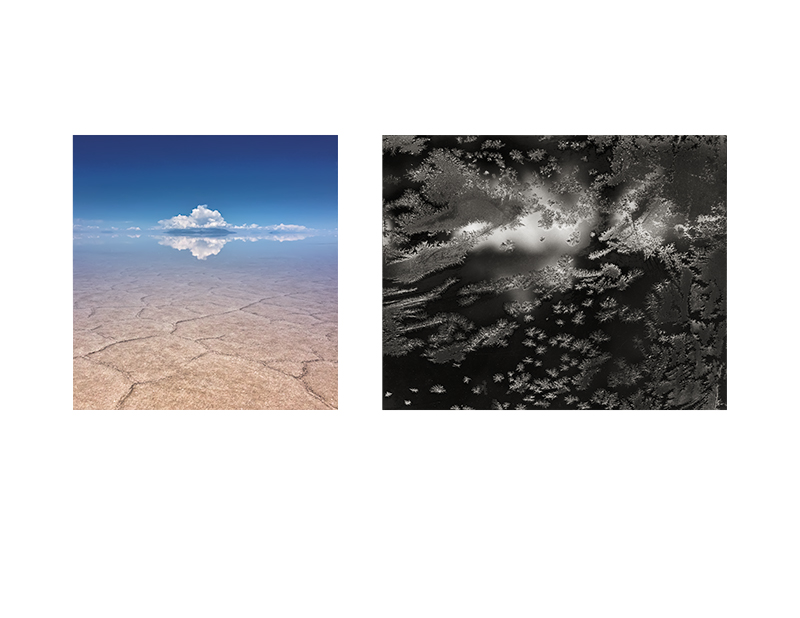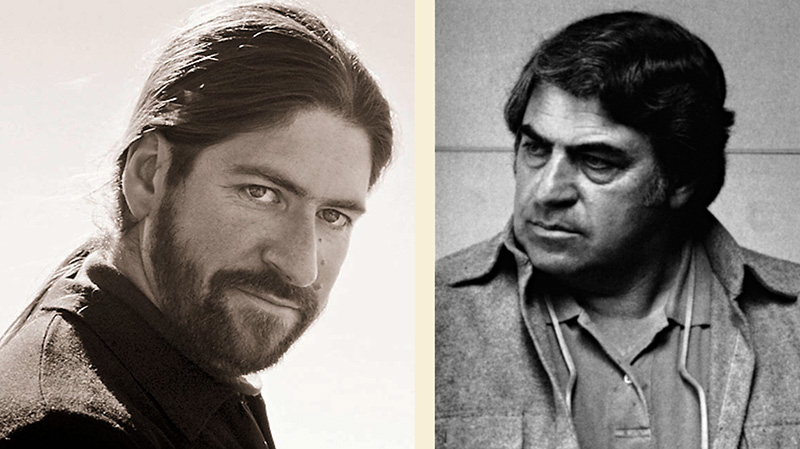 John Paul Caponigro, Uyuni, Bolivia, 2012, and Paul Caponigro, Frosted Window, Revere, Massachusetts, 1957, printed together on one 17x22" sheet
John Paul Caponigro, Uyuni, Bolivia, 2012, and Paul Caponigro, Frosted Window, Revere, Massachusetts, 1957, printed together on one 17x22" sheet
Pictures can work in pairs. The interplay of their tensions and their consonances can work off each other and give the eye and the mind more to contemplate. This is something most of us learned from books, where pictures on facing pages often share a spread.
I learned it primarily from a wonderful 1984 book called The Wise Silence by the landscapist Paul Caponigro, one of the major American art photographers of the second half of the 20th century. The distinguished designer of that book, Eleanor Morris, who still uses Eleanor Morris Caponigro as her professional name, was married to Paul at the time. She designed many famous photo books, working with artists such as Eliot Porter, Laura Gilpin, William Clift, and Georgia O'Keefe. She has a particular gift for the mysterious art of pairing facing pictures, and worked in concert with Paul on that aspect of The Wise Silence.
Their son is John Paul Caponigro, who will need as little introduction to photographers of the digital age as his father Paul does to photographers of his generation. John Paul has deliberately sought to exploit the creative potential of digital imaging at every step of its evolution and at every stage of his career. His accomplishments are many, from consulting with Adobe and Epson on the development of their products to presenting Google and TED talks on creativity.
An era in one artwork
I'm pleased to say that this is the first original artwork ever created specifically and exclusively for our ongoing series of TOP print sales. The pairing highlights the differences of the two pictures the father and son created and chose, differences that mirror the current age of change in photography: digital and film, color and black-and-white, large format film and small-sensor digital, old and new...it's an early picture of Paul's, taken eight years before John Paul was born, and a picture from John Paul's latest work, made in Bolivia just last year. The cameras are a contrast of old and new—the 4x5 Deardorff Paul used was somewhat antiquarian even in 1957, when 35mm was the latest, hottest thing (the Leica M3 was a mere four years old that year), and John Paul's picture was taken with an Apple iPhone 5 and processed with Google's Snapseed app. John Paul was among the first photographers to use cameraphones for creative work—his first iPhone was recently acquired for the permanent collection of the Smithsonian Institution for that reason. (The Smithsonian will also be acquiring this print for its collection.)
And yet despite all the differences, it's the way these two pictures still work together as a pair that's remarkable. John Paul chose his picture first, and Paul chose the pairing. Paul selected the paper type (Epson Velvet Fine Art). John Paul made the print (on an Epson 3880 with Epson Ultrachrome K3 inks with Vivid Magenta). Paul sat with his son to consult as the print was processed and proofed.
Each print will be signed by both photographers.
 John Paul (left) and Paul Caponigro
John Paul (left) and Paul Caponigro
In case you aren't familiar with the way our sales work, we collect orders for a limited time—five days—and then the prints are made to fulfill the orders we receive. In that way, we can offer fine art prints that are priced considerably lower than they would be if they were sold by traditional galleries. (For comparison, consider that John Paul's usual print prices start at $2,000 and Paul's start at $5,000, and both sell steadily and well at those prices.) So it's a great opportunity for TOP readers. Yet the photographers still do very well because they can print in volume knowing that each print they make is already sold. Plus, the photographers keep a full 80% of the proceeds—again quite unlike traditional galleries, which often must take as much as 60 or 70% of the proceeds of sales in commission. The final third of this "win-win-win" proposition is that TOP's share of the proceeds helps keep the website going.
The single print consists of both pictures printed together on one 17x22" sheet. Image sizes are 7.5" square and 7.5x9.5". International orders are welcome. The prints costs $495 plus shipping; please allow up to eight weeks for delivery, although many prints will arrive sooner than that. There is no limit to the number of prints any individual can order or that we will sell in the sale, but the prints will be numbered and limited to however many are sold in this five day period. Paul's picture has been printed before as a silver print and might be sold again alone, but John Paul has never printed his picture before and never will again—so, for these pictures presented comme paire, this is it.
The sale starts now and ends this coming Friday, September 20th, at 9 p.m. Maine time, and all orders must be received by that deadline.
[Link removed—sale ended 9/20/13]
For my part, I'd like to thank John Paul and Paul and all the people at John Paul's studio who have worked so hard on this. And as always, I hope you like the print!
Mike
Original contents copyright 2013 by Michael C. Johnston and/or the bylined author. All Rights Reserved. Links in this post may be to our affiliates; sales through affiliate links may benefit this site.
(To see all the comments, click on the "Comments" link below.)
Featured Comments from:
Barry: "I'm confused about the cost. Is it $495 for one piece of paper with two images on it, or is it $495 per image = $990 for the pair?"
Mike replies: I should thank you for this question...it didn't occur to me that this might not be clear. It's both pictures printed together on one 17x22" sheet of paper. The price is for a single print that includes both pictures side by side. I've modified the post to make this more clear.


